Themed collection FOCUS: Recent progress on aggregation-induced emission

AIE polymers in sensing, imaging and theranostic applications
This review summarizes the progress of AIE polymers in sensing, imaging and theranostic applications in the recent 3 years, and the perspective and future development of AIE polymers are discussed briefly.
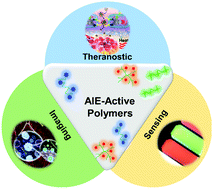
Mater. Chem. Front., 2021,5, 4073-4088
https://doi.org/10.1039/D1QM00078K
Materials with aggregation-induced emission characteristics for applications in diagnosis, theragnosis, disease mechanism study and personalized medicine
In this review, we introduce the recent progress on the employment of AIE-active materials for healthcare-related applications, such as clinical diagnosis, theragnosis, disease mechanism studies and personalized medicines.
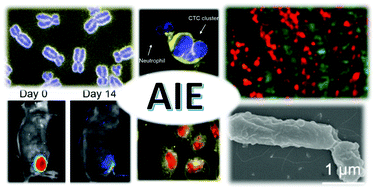
Mater. Chem. Front., 2021,5, 3322-3343
https://doi.org/10.1039/D0QM01132K
Organometallic AIEgens for biological theranostics
The marriage of AIEgens and organometallic complexes has shown great potential in biological probes and photosensitizers.
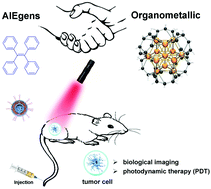
Mater. Chem. Front., 2021,5, 3281-3297
https://doi.org/10.1039/D0QM01130D
Recent progress of aggregation-induced emission luminogens (AIEgens) for bacterial detection and theranostics
The emergence and global spread of bacterial infections in clinical practice has become a public health problem. We provide a detailed and comprehensive summary of the application of AIEgens for bacterial detection and treatments.

Mater. Chem. Front., 2021,5, 1164-1184
https://doi.org/10.1039/D0QM00753F
Recent advances in cation sensing using aggregation-induced emission
This review summarizes recent advances in AIE-based chemosensors for the detection of a wide range of metal cations, outlining the various sensing mechanisms and sensing performances such as sensitivity and selectivity of AIE-based chemosensors.
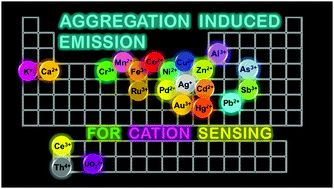
Mater. Chem. Front., 2021,5, 659-708
https://doi.org/10.1039/D0QM00607F
Wash-free detection and bioimaging by AIEgens
Herein, the latest progress of AIEgens for application in wash-free detection and bioimaging was reviewed.
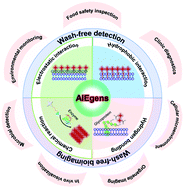
Mater. Chem. Front., 2021,5, 723-743
https://doi.org/10.1039/D0QM00586J
Nanoprobes with aggregation-induced emission for theranostics
This review summarizes the latest advancement of nanoprobes with aggregation-induced emission (AIE) for image-guided therapy.

Mater. Chem. Front., 2021,5, 603-626
https://doi.org/10.1039/D0QM00617C
Theoretical insights into the rational design of small organic phototheranostic agents for promoting image-guided cancer surgery
Through multiscale modeling, it is predicted that TSSSSI is a potential candidate for NIR-II FLI-guided PDT–PTT therapy.

Mater. Chem. Front., 2023,7, 545-553
https://doi.org/10.1039/D2QM01227H
AIEgens for dual second harmonic generation and fluorescence “turn-on” imaging of membrane and photodynamic therapy in cancer cells
The integration of second harmonic generation (SHG) microscopic imaging and aggregation-induced emission fluorescence imaging would greatly boost the imaging outcomes because of the combination of merits in each imaging modality.

Mater. Chem. Front., 2023,7, 502-513
https://doi.org/10.1039/D2QM01081J
Cationic AIE-active photosensitizers for highly efficient photodynamic eradication of drug-resistant bacteria
A cationization and cyano introduction molecular engineering strategy is reported to develop AIE-active photosensitizers for high-efficiency PDT eradication of drug-resistant bacteria.
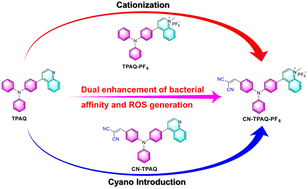
Mater. Chem. Front., 2023,7, 96-105
https://doi.org/10.1039/D2QM01043G
Backbone flexibility/amphiphilicity modulation of AIE active polyelectrolytes for mitochondria- and nucleus-targeted synergistic photodynamic therapy of cancer cells
Mitochondria- and nucleus-targeted photodynamic therapy (PDT) to locally destruct organelles that play vital roles in physiologic processes holds great promise.

Mater. Chem. Front., 2022,6, 3678-3690
https://doi.org/10.1039/D2QM00761D
Isoquinolinium-based photosensitizers with aggregation-induced emission characteristics for highly efficient photodynamic combat of viruses
This work presents the highly efficient photodynamic combat of viruses by employing three isoquinolinium-based photosensitizers with aggregation-induced emission characteristics.

Mater. Chem. Front., 2022,6, 3042-3053
https://doi.org/10.1039/D2QM00630H
A tris-tetrazole based nanostructured soft material: studies on self-healing, AIEE, and rheological and fluorometric detection of 3-aminopyridine
Detection of 3-aminopyridine by tris-tetrazole based organogelator G8 through donor–acceptor mechanism.

Mater. Chem. Front., 2022,6, 2835-2847
https://doi.org/10.1039/D2QM00520D
Naphthaldehyde-based Schiff base dyes: aggregation-induced emission and high-contrast reversible mechanochromic luminescence
This work provides a naphthaldehyde-based Schiff base with reversible multiple stimuli-responsive behaviour of AIEE mechanochromic luminescence, which functions as a sensitive chemosensor for Cu2+ ions.

Mater. Chem. Front., 2022,6, 2491-2498
https://doi.org/10.1039/D2QM00542E
Facile construction of AIE-active pyridinyl-diphenylacrylonitrile derivatives with optical properties finely modulated by D–A regulation
AIE-active PyDPACNs with tunable emission covering visible light region were facilely constructed. Role reversal of pyridinyl was revealed. Synergistic light-activated and dark cytotoxicity made PyDPACN-TCF promising for image-guided dual-therapy.
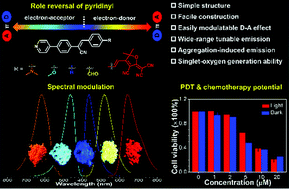
Mater. Chem. Front., 2022,6, 2103-2113
https://doi.org/10.1039/D2QM00477A
Novel class of organic crystal scintillators based on aggregation-induced emission
We synthesized 1,1,2,3,4,5-hexaphenyl-1H-silole (HPS) crystals to develop organic crystal scintillators based on aggregation-induced emission (AIE).
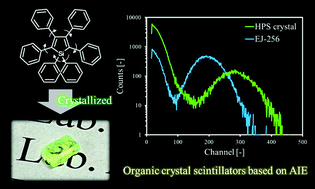
Mater. Chem. Front., 2022,6, 1470-1476
https://doi.org/10.1039/D2QM00187J
A responsive AIE-active fluorescent probe for visualization of acetylcholinesterase activity in vitro and in vivo
An aggregation-induced emission (AIE) active light up fluorescent probe (TCFPB-AChE) was developed for selective in vitro and in vivo imaging of acetylcholinesterase activity.

Mater. Chem. Front., 2022,6, 1515-1521
https://doi.org/10.1039/D2QM00239F
A brightly red emissive AIEgen and its antibody conjugated nanoparticles for cancer cell targeting imaging
Antibody decorated nanoparticles with brightly red emissions are promising probes for targeted detection of cancer cells due to their excellent specificity, deep penetration depth, high photostability and low phototoxicity.
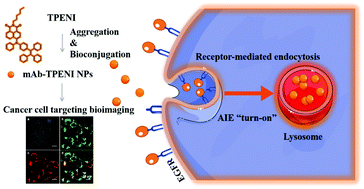
Mater. Chem. Front., 2022,6, 1317-1323
https://doi.org/10.1039/D2QM00273F
An environmentally friendly AIE probe for CMC determination
We first report an AIE probe EDS for rapid CMC determination of anionic and non-ionic surfactants in an environmentally friendly system.
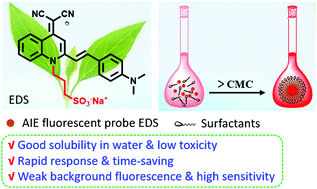
Mater. Chem. Front., 2022,6, 1005-1009
https://doi.org/10.1039/D2QM00056C
A new cucurbit[10]uril-based AIE fluorescent supramolecular polymer for cellular imaging
The synthesis of the AIE fluorescent supramolecular polymer TPE-B@Q[10] is reported. This system exhibits excellent blue emission properties, good biocompatibility and was successfully employed for cytoplasmic imaging of cells.
![Graphical abstract: A new cucurbit[10]uril-based AIE fluorescent supramolecular polymer for cellular imaging](/en/Image/Get?imageInfo.ImageType=GA&imageInfo.ImageIdentifier.ManuscriptID=D2QM00084A&imageInfo.ImageIdentifier.Year=2022)
Mater. Chem. Front., 2022,6, 1021-1025
https://doi.org/10.1039/D2QM00084A
Amphiphilic rhomboidal metallacycles with aggregation-induced emission and aggregation-caused quenching luminogens for white-light emission and bioimaging
Three rhomboidal metallacycles are formed by metal-ligand interactions. Due to the integration of AIEgens and ACQphores, metallacycles exhibit tunable emission. And the amphiphilic structures promote the formation of micelles used for cell imaging.

Mater. Chem. Front., 2022,6, 633-643
https://doi.org/10.1039/D1QM01630J
Tricolor fluorescence switching in the three crystal polymorphs of tetraphenylethylene modified fluorenone AIEgen
We employ the molecular design strategy of introducing multiple weak interactions and twisted molecular structure into the same molecular system to synthesize a new AIEgen, which exhibited stimuli-responsive crystalline tricolor fluorescent switching.

Mater. Chem. Front., 2022,6, 613-622
https://doi.org/10.1039/D1QM01532J
Stacking-dependent tetracolour luminescence and mechanofluorochromic properties of an isoquinoline derivative with aggregation-induced emission
An AIE-active isoquinoline derivative containing ethyl (E)-2-cyano-3-phenylacrylate unusually has four crystalline structures which exhibit reversible and tetracolour switching mechanofluorochromic activities.

Mater. Chem. Front., 2022,6, 459-465
https://doi.org/10.1039/D1QM01503F
Three birds with one stone: a single AIEgen for dual-organelle imaging, cell viability evaluation and photodynamic cancer cell ablation
We report the first single AIEgen that has great potential for dual-imaging of mitochondria/LDs, detection of cell viability and simultaneously photodynamic ablation of cancer cells.

Mater. Chem. Front., 2022,6, 333-340
https://doi.org/10.1039/D1QM01270C
Aggregation-induced emission (AIE)-active N-arylated ferrocenyl pyrazole chromophores: second-order nonlinear optical and turn on/off fluorescence for the detection of picric acid in mixed aqueous media
AIE-active N-arylated ferrocenyl pyrazoles show SHG efficiencies and used as highly selective and sensitive fluorescent sensors for the detection of picric acid in mixed aqueous media.

Mater. Chem. Front., 2021,5, 8290-8307
https://doi.org/10.1039/D1QM01022K
AIE ligand-based silver clusters used for ethion detection
A silver cluster of Ag24 containing an aggregation-induced emission (AIE) ligand was prepared and used as a potential chemosensor for detecting ethion in water dominated solutions, and exhibited good selectivity and sensitivity.

Mater. Chem. Front., 2021,5, 7982-7986
https://doi.org/10.1039/D1QM01181B
Living supramolecular polymerization of an AIE-active Ir(III) complex with irregular emission
The aggregation mechanism of an AIE-active Ir(III) complex 1 with irregular emission has been studied. The living supramolecular polymerization of 1 has been successfully performed and the sizes of supramolecular polymers can be controlled.

Mater. Chem. Front., 2021,5, 7808-7816
https://doi.org/10.1039/D1QM01012C
AIE-based donor–acceptor–donor fluorenone compound as multi-functional luminescence materials
A novel fluorenone-based luminescent material with multi-stimuli responsive and multi-functional properties is reported.
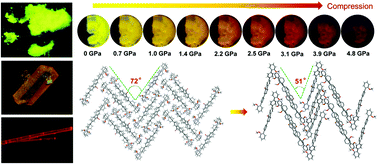
Mater. Chem. Front., 2021,5, 7508-7517
https://doi.org/10.1039/D1QM00856K
Aggregation-induced emission nanoparticles with NIR and photosensitizing characteristics for resistant bacteria elimination and real-time tracking
Because of the steady increase in multi-drug-resistant bacterial infections, we developed a viable treatment strategy using new antibacterial nanomaterials with photosensitizing effects.

Mater. Chem. Front., 2021,5, 6611-6617
https://doi.org/10.1039/D1QM00752A
A DNA tetrahedron-loaded natural photosensitizer with aggregation-induced emission characteristics for boosting fluorescence imaging-guided photodynamic therapy
A natural AIE-active PS (PaH) is utilized to bind into DNA-T for cancer theranostics. The constructed PaH@DNA-T exhibits highly boosted fluorescence intensity and ROS generation, as well as much higher cell uptake efficiency.

Mater. Chem. Front., 2021,5, 5410-5417
https://doi.org/10.1039/D1QM00420D
Well-defined organic fluorescent nanomaterials with AIE characteristics for colorimetric/UV-vis/fluorescent multi-channel recognition of Zn2+ with multiple applications in plant cells and zebrafish
A probe was synthesized that could detect Zn2+ using AIE in plants and zebrafish.

Mater. Chem. Front., 2021,5, 4981-4988
https://doi.org/10.1039/D1QM00404B
AIE-active 9,10-azaboraphenanthrene-containing viologens for reversible electrochromic and electrofluorochromic applications
A series of novel AIE-active 9,10-azaboraphenanthrene-containing viologens (BNPV2+) for electrochromism, electrofluorochromism and reversible data encryption system is reported.
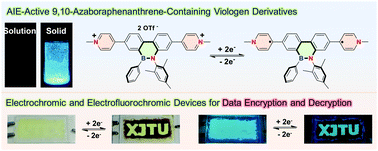
Mater. Chem. Front., 2021,5, 4128-4137
https://doi.org/10.1039/D1QM00327E
Boosting the AIEgen-based photo-theranostic platform by balancing radiative decay and non-radiative decay
A single-molecule-triggered photo-theranostic platform with aggregation-induced emission feature for precise diagnosis and efficient cancer therapy is developed.
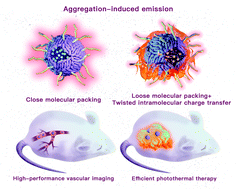
Mater. Chem. Front., 2021,5, 4182-4192
https://doi.org/10.1039/D0QM01035A
Biologically-derived nanoparticles for chemo-ferroptosis combination therapy
The use of biologically-derived nanoparticles from mung beans for combination chemo-ferroptosis therapy and magnetic resonance imaging is reported, which highlights the potential of the nanoparticles for biomedical applications.

Mater. Chem. Front., 2021,5, 3813-3822
https://doi.org/10.1039/D1QM00295C
Hydrogen peroxide-responsive AIE probe for imaging-guided organelle targeting and photodynamic cancer cell ablation
A versatile red/near-infrared AIE probe, TTPy-H2O2, was developed for the specific visualization of H2O2 with mitochondria targeting ability, meanwhile achieving efficient photodynamic therapy for cancer cells.
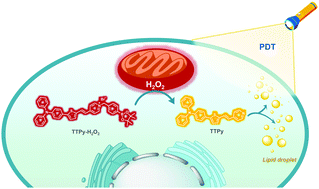
Mater. Chem. Front., 2021,5, 3489-3496
https://doi.org/10.1039/D1QM00328C
Photodynamic antitumor activity of aggregation-induced emission luminogens as chemosensitizers for paclitaxel by concurrent induction of apoptosis and autophagic cell death
TPE-Py inhibits the growth of tumor cells by inducing apoptotic and autophagic cell death, and the effect could be enhanced by white light irradiation. TPE-Py enhances the anticancer activity of Ptx by inducing apoptosis by white light irradiation.
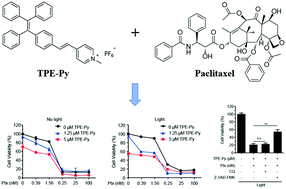
Mater. Chem. Front., 2021,5, 3448-3457
https://doi.org/10.1039/D1QM00089F
AIE-nanoparticle assisted ultra-deep three-photon microscopy in the in vivo mouse brain under 1300 nm excitation
Here we present organic AIE nanoparticles that feature high absorption cross-section under NIR-IIa three-photon excitation, which enables ultra-deep three-photon fluorescence imaging in the in vivo mouse brain.

Mater. Chem. Front., 2021,5, 3201-3208
https://doi.org/10.1039/D1QM00243K
A near-infrared AIE probe for super-resolution imaging and nuclear lipid droplet dynamic study
A near-infrared AIE probe was developed for super-resolution imaging and nuclear lipid droplets dynamic study with good biocompatibility and high photostability.
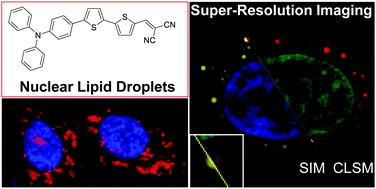
Mater. Chem. Front., 2021,5, 3043-3049
https://doi.org/10.1039/D0QM00914H
A positively charged aggregation-induced emission (AIE) luminogen as an ultra-sensitive mechanochromic luminescent material: design, synthesis and versatile applications
Nowadays, the rational design of a mechanochromic luminescent (ML) material with ultra-sensitivity toward external stimuli is a greatly challenging task.

Mater. Chem. Front., 2021,5, 2849-2859
https://doi.org/10.1039/D0QM01047B
Rapid membrane-specific AIEgen featuring with wash-free imaging and sensitive light-excited killing of cells, bacteria, and fungi
C6-BD equipped with AIE and ESIPT characteristics was used to visualize the cell membrane with high selectivity, stability, and wash-free operation. It also universal for imaging of bacteria and fungi with light-excited killing via ROS generation.

Mater. Chem. Front., 2021,5, 2724-2729
https://doi.org/10.1039/D0QM01046D
Novel strategy to prepare fluorescent polymeric nanoparticles based on aggregation-induced emission via precipitation polymerization for fluorescent lateral flow assay
A novel strategy to prepare fluorescent polymeric nanoparticles based on aggregation-induced emission via precipitation polymerization for fluorescent lateral flow assay.
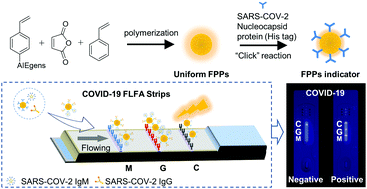
Mater. Chem. Front., 2021,5, 2452-2458
https://doi.org/10.1039/D0QM00998A
Color-tunable tetracoordinated organoboron complexes exhibiting aggregation-induced emission for the efficient turn-on detection of fluoride ions
A aggregation-induced emission-characterized tetracoordinated organoboron complex-based probe for the turn-on detection of fluoride ion is reported.

Mater. Chem. Front., 2021,5, 2353-2360
https://doi.org/10.1039/D1QM00046B
Unique dual fluorescence emission in the solid state from a small molecule based on phenanthrocarbazole with an AIE luminogen as a single-molecule white-light emissive material
New triphenylethylene-phenanthrocarbazole (PCTrPE) was the first small molecule that exhibited dual fluorescence emission in the solid state providing a new strategy to realize a single-molecule white emissive material for white OLEDs.

Mater. Chem. Front., 2021,5, 2361-2372
https://doi.org/10.1039/D0QM00951B
Sensitive and specific detection of peroxynitrite and in vivo imaging of inflammation by a “simple” AIE bioprobe
A facile synthesized AIE bioprobe was developed to detect peroxynitrite sensitively and specifically. This bioprobe can realize both in vitro ONOO− detection and in vivo visualization of inflammation.
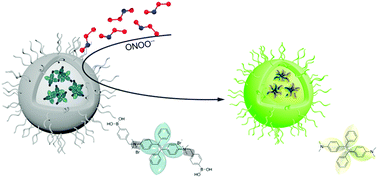
Mater. Chem. Front., 2021,5, 1830-1835
https://doi.org/10.1039/D0QM01004A
Biomarker-responsive nanoprobe with aggregation-induced emission for locating and guiding resection of deep-seated tumors via optoacoustic and NIR fluorescence imaging
A nanoprobe responsive to specific biomarkers with aggregation-induced emission has been developed for locating and guiding resection of tumors via optoacoustic and fluorescence imaging.

Mater. Chem. Front., 2021,5, 1962-1970
https://doi.org/10.1039/D0QM00904K
An easily available ratiometric AIE probe for nitroxyl visualization in vitro and in vivo
An easily available ratiometric fluorescent probe (TCFPB-HNO) with aggregation-induced emission (AIE) characteristics was developed for the first time for the detection and visualization of nitroxyl (HNO) in vitro and in vivo.
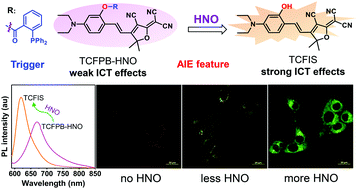
Mater. Chem. Front., 2021,5, 1817-1823
https://doi.org/10.1039/D0QM00995D
Host–guest interaction-induced emission enhancement of amphiphilic AIEgens: a computational study
Host–guest interactions, including hydrophobic interactions, intermolecular H-bonds and O–H⋯π interactions, play important roles in the photophysical properties of amphiphilic AIEgens.
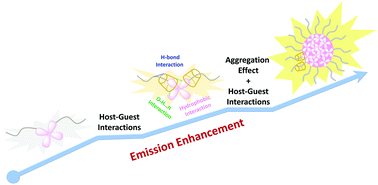
Mater. Chem. Front., 2021,5, 1806-1816
https://doi.org/10.1039/D0QM00942C
Diagnosis of fatty liver disease by a multiphoton-active and lipid-droplet-specific AIEgen with nonaromatic rotors
We present a two-photon AIEgen, ABCXF with nonaromatic rotors (–CF3), a high two-photon absorption cross-section, bright red emission in the solid-state, and remarkably high photostability for fatty liver disease diagnosis.
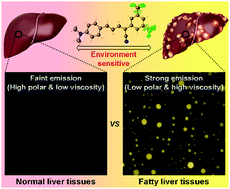
Mater. Chem. Front., 2021,5, 1853-1862
https://doi.org/10.1039/D0QM00877J
An easily synthesized AIE luminogen for lipid droplet-specific super-resolution imaging and two-photon imaging
A synergetic imaging platform was established to achieve LDs-specific imaging by STED nanoscopy and TPF microscopy. Benefiting from its high PLQYs, outstanding photo-stability, and high LDs specificity, a superior resolution in cells and a deep penetration depth in tissues were achieved.
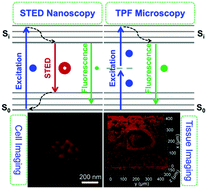
Mater. Chem. Front., 2021,5, 1872-1883
https://doi.org/10.1039/D0QM00682C
Supramolecular nanoparticles constructed from pillar[5]arene-based host–guest complexation with enhanced aggregation-induced emission for imaging-guided drug delivery
Supramolecular nanoparticles with enhanced aggregation-induced emission are prepared by taking advantage of pillar[5]arene-based host–guest complexation, and are sophisticated nanocarriers for imaging-guided drug delivery.
![Graphical abstract: Supramolecular nanoparticles constructed from pillar[5]arene-based host–guest complexation with enhanced aggregation-induced emission for imaging-guided drug delivery](/en/Image/Get?imageInfo.ImageType=GA&imageInfo.ImageIdentifier.ManuscriptID=D0QM00974A&imageInfo.ImageIdentifier.Year=2021)
Mater. Chem. Front., 2021,5, 1418-1427
https://doi.org/10.1039/D0QM00974A
Quinoline-based TADF emitters exhibiting aggregation-induced emission for efficient non-doped organic light-emitting diodes
Three quinoline-based TADF emitters with aggregation-induced emission were synthesized and fabricated for efficient non-doped OLEDs with EQEmax up to 17.3%.

Mater. Chem. Front., 2021,5, 834-842
https://doi.org/10.1039/D0QM00628A
A highly sensitive humidity sensor based on an aggregation-induced emission luminogen-appended hygroscopic polymer microresonator
A self-assembled microsphere resonator, comprising a hygroscopic polymer with aggregation-induced emission luminogen pendants, can sense humidity with high sensitivity and repeatability.
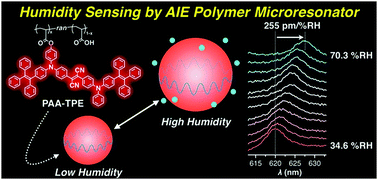
Mater. Chem. Front., 2021,5, 799-803
https://doi.org/10.1039/D0QM00722F
Understanding the lipid production mechanism in Euglena gracilis with a fast-response AIEgen bioprobe, DPAS
The aggregation-induced emission (AIE) bioprobe, DPAS can rapidly and easily detect lipid drops in Euglena gracilis as highly valued metabolites under nitrogen and calcium deprivation and glucose supplementation in darkness.
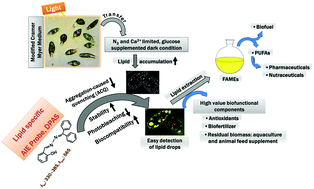
Mater. Chem. Front., 2021,5, 268-283
https://doi.org/10.1039/D0QM00621A
An AIE luminogen-based electropolymerized film: an ultrasensitive fluorescent probe for TNP and Fe3+ in water
A fluorescent POP film (polyPhTPECz) which acted as an excellent multifunctional and reusable fluorescent probe was prepared by using an electropolymerization (EP) method.

Mater. Chem. Front., 2021,5, 492-499
https://doi.org/10.1039/D0QM00543F
Multifunctional AIE-ESIPT dual mechanism tetraphenylethene-based Schiff base for inkless rewritable paper and a colorimetric/fluorescent dual-channel Zn2+ sensor
An AIE-ESIPT-active compound was rationally designed and facilely developed, which exhibits multifunctional applications in inkless rewritable paper, a colorimetric/fluorescent dual-channel sensor for Zn2+ ions and fluorescence imaging of Zn2+ ions in living cells.
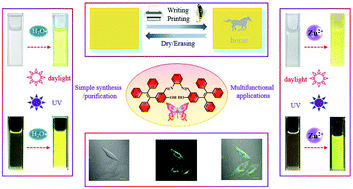
Mater. Chem. Front., 2021,5, 347-354
https://doi.org/10.1039/D0QM00623H
Small organic molecule-based nanoparticles with red/near-infrared aggregation-induced emission for bioimaging and PDT/PTT synergistic therapy
An organic small molecule T-BDP with D–A–D structure was designed and synthesized and could self-assemble into nanoparticles with significant AIE performance. Under 635 nm laser irradiation, T-BDP NPs ablate cancer cells through photodynamic/photothermal synergistic effects.
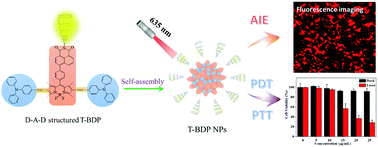
Mater. Chem. Front., 2021,5, 406-417
https://doi.org/10.1039/D0QM00536C
About this collection
Materials Chemistry Frontiers is delighted to introduce you the following collection of articles on “aggregation-induced emission”. Articles featured in our focus collections are handpicked by Editors. We hope you find them enjoyable to read. Access is free till 30 October.